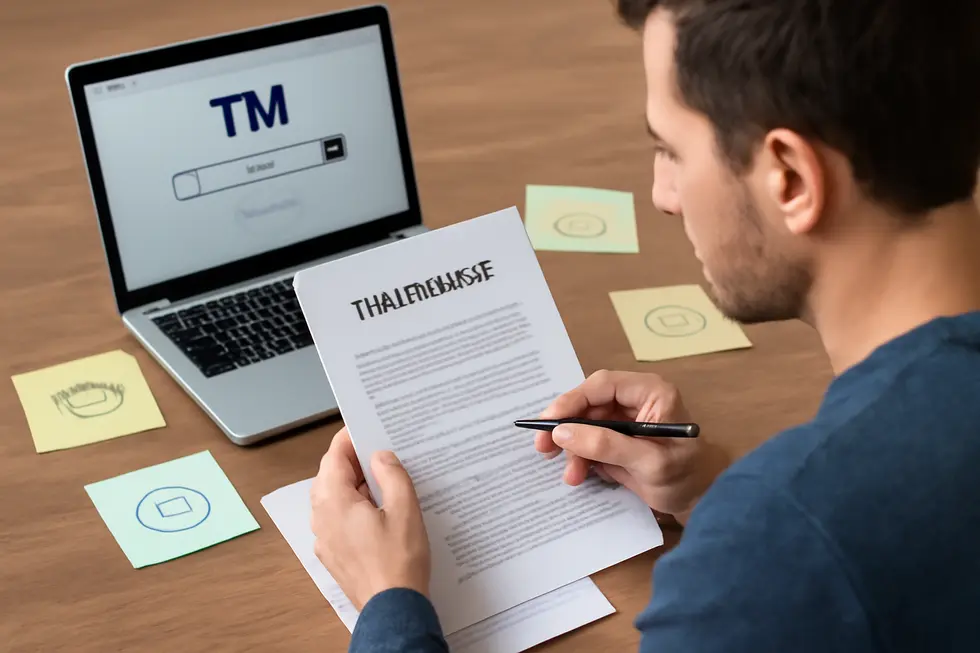Introduction
A business name is more than just an identifier—it’s a vital part of your brand’s identity and value. But what happens if someone else successfully trademarks the very name you use? The possibility that another party could trademark your business name before you do raises important questions about ownership, legal rights, and how to protect your brand. This guide explores the key aspects business owners need to grasp: recognizing when someone can trademark your business name, the legal consequences if that occurs, ways others might secure your name first, and how you can proactively prevent such disputes. Finally, it covers practical steps to resolve conflicts if someone trademarks your business name. Understanding these points will empower you to safeguard your business and ensure your brand identity remains uniquely yours.
Tables of Contents
Chapter 1: Understanding if Someone Can Trademark My Business Name
- Legal Criteria and Eligibility: When Can Someone Trademark Your Business Name?
- Navigating the Trademark Search and Registration Journey to Protect Your Business Name
- Navigating Risks and Resolving Conflicts: Protecting Your Business Name from Trademark Challenges
Chapter 2: Legal Impacts and Recourse When Someone Else Trademarks Your Business Name
- Navigating Trademark Infringement Risks and Enforcement Strategies
- Protecting Your Brand: Navigating Legal Strategies When Others Trademark Your Business Name
- Navigating Economic and Societal Ripple Effects of Trademark Conflicts
Chapter 3: How Can Someone Trademark My Business Name Before Me?
- Navigating the Race: Legal Steps and Timing Risks in Trademarking Your Business Name
- Navigating Trademark Priority: Prior Use, Geographic Rights, and Preemptive Registrations
- Securing Your Business Name: How to Prevent Premature Trademark Claims and What to Do If It Happens
Chapter 4: Preventive Measures Against Someone Trademarking My Business Name
- Navigating Legal Protections and Strategic Steps to Secure Your Business Name
- Leveraging Advanced Technologies to Guard Your Business Name from Unauthorized Trademarking
- The Broader Economic and Social Stakes of Protecting Your Business Name
Chapter 5: Resolving conflicts if someone trademarks my business name
- Navigating Legal Remedies When Your Business Name Is Registered by Another
- Harnessing Negotiation and Mediation to Settle Trademark Name Disputes
- Proactive Strategies to Safeguard Your Business Name from Trademark Conflicts
Chapter 1: Understanding if Someone Can Trademark My Business Name

1. Legal Criteria and Eligibility: When Can Someone Trademark Your Business Name?
Trademarking a business name involves meeting specific legal requirements that determine eligibility and priority of rights. At the core, a business name must be sufficiently distinctive to identify the source of goods or services without causing consumer confusion. Names that are generic or merely descriptive are often denied protection unless they acquire secondary meaning. More distinctive names—suggestive, arbitrary, or fanciful—enjoy stronger trademark protection. Another critical factor is whether the name conflicts with existing trademarks. If a name closely resembles a previously registered mark in appearance, sound, or meaning, especially within the same industry, it generally cannot be trademarked due to the risk of confusion. Additionally, the name must not be deceptive, scandalous, or falsely imply affiliation with other entities. In many jurisdictions, applicants must show actual use or intent to use the name commercially. Since trademark rights might belong to whoever registers first or uses the name first in commerce, someone else can lawfully trademark your business name if you have not secured registration, particularly in the same market or class of goods. To safeguard your brand, understanding these legal criteria is essential before attempting registration. For deeper insights, explore guidance on how a trademark can protect your brand identity effectively.
2. Navigating the Trademark Search and Registration Journey to Protect Your Business Name
Before someone can trademark your business name, a thorough trademark search and registration process must be completed. This process begins with a comprehensive search to identify existing trademarks that may conflict with your proposed name. Searching the trademark database ensures that your desired name is unique and does not infringe on existing rights. If similar marks are already registered, your registration could be denied or challenged later. Once the search confirms availability, the next step is submitting a trademark application with the relevant government office, detailing the business name, goods or services it will cover, and its intended use. During examination, officials assess the mark’s distinctiveness and potential conflicts. If approved, your trademark grants you exclusive rights to use the name for specified categories, helping prevent others from using confusingly similar names. This strategic process is essential for establishing legal protection and brand identity. For deeper insight, see the guide on how to trademark your business name.
3. Navigating Risks and Resolving Conflicts: Protecting Your Business Name from Trademark Challenges
Trademarking a business name can be complex when others claim rights to the same or similar marks. Risks include potential legal conflicts if a name is already trademarked, which may lead to costly disputes or forced rebranding. Understanding these conflicts is crucial for business owners to avoid infringement issues. Early trademark searches help identify existing trademarks that could pose challenges. If a conflict arises, strategies like negotiating coexistence agreements or modifying the branding may be necessary. Proactively registering your trademark strengthens your legal position and helps prevent others from claiming your business name. Protection extends beyond registration, requiring vigilance to detect unauthorized uses and enforcing your rights promptly. This process safeguards brand identity and supports long-term business growth. For more insights on securing your brand identity through trademark registration, explore how to trademark your business name.
Chapter 2: Legal Impacts and Recourse When Someone Else Trademarks Your Business Name

1. Navigating Trademark Infringement Risks and Enforcement Strategies
When another party registers a trademark identical or similar to your business name, significant legal challenges arise that can impact your brand’s value and operations. Trademark infringement occurs when a registered mark creates a likelihood of confusion among consumers about the source of goods or services. This can limit your ability to use your own business name, restrict expansion, and expose you to legal action such as cease-and-desist letters or lawsuits. Courts evaluate infringement by examining the similarity of the marks, the relatedness of the markets, and potential consumer confusion. While common law rights may offer some protection if you used the name first, registered trademark rights usually provide broader, enforceable nationwide protection. Remedies include opposing or canceling the conflicting trademark registration, negotiating coexistence agreements, or pursuing litigation to assert your prior use rights. In some cases, rebranding may become necessary if enforcement proves impractical. Proactive trademark registration and vigilant monitoring are essential to minimize these risks and safeguard your brand. For a deeper understanding of protecting business identity through trademark law, see legally protected brand trademark.
2. Protecting Your Brand: Navigating Legal Strategies When Others Trademark Your Business Name
When someone else trademarks your business name, it poses critical legal challenges that demand a strategic response under intellectual property law. The first step involves assessing whether the registered trademark genuinely conflicts with your prior usage or established common law rights. If you have been using the business name before their registration, you may hold enforceable rights despite their trademark, especially within your geographic market. Legal remedies include opposing the trademark during its application process or petitioning for cancellation if it is already registered, typically on grounds of likelihood of confusion or bad faith.
To protect your business, it is vital to document your prior use extensively and consider registering your own trademark, which strengthens your position significantly. Engaging with an intellectual property attorney can help navigate cease-and-desist negotiations or litigation, while also advising on potential rebranding if necessary. Proactive trademark registration and monitoring are essential to prevent unauthorized filings by third parties. For a deeper understanding of how to safeguard your brand identity through trademarks, see this comprehensive guide on legally protected brand trademarks.
3. Navigating Economic and Societal Ripple Effects of Trademark Conflicts
When someone else trademarks your business name, the consequences ripple beyond legal disputes, significantly impacting both economic stability and societal interactions. Economically, businesses face costly litigation or the burden of rebranding, which can drain resources and disrupt market presence. Losing a trademark can result in lost customer loyalty and diminished brand equity, putting smaller enterprises at a disadvantage against well-established competitors. Societally, trademark conflicts may confuse consumers, dilute brand identity, and erode trust within the marketplace—a challenge particularly critical in industries driven by reputation and recognition. Moreover, these disputes can stifle innovation, as emerging businesses hesitate to invest in unique branding for fear of infringement. Understanding these broader effects emphasizes the importance of proactive trademark protection and highlights how legal ownership extends well beyond paperwork. To safeguard your brand effectively, consider learning more about the benefits of securing your intellectual property through comprehensive trademark registration, explained in detail here.
Chapter 3: How Can Someone Trademark My Business Name Before Me?

1. Navigating the Race: Legal Steps and Timing Risks in Trademarking Your Business Name
The risk of someone trademarking your business name before you hinges largely on the legal process and timing involved in securing trademark rights. Trademark protection generally follows a “first to file” system in many jurisdictions, meaning the earliest valid application gets priority, regardless of who used the name first. This underscores the importance of promptly filing a trademark application once you decide to protect your name.
The trademark registration process involves submitting an application with the appropriate intellectual property office, where it undergoes examination for conflicts with existing marks. During this examination, third parties may oppose your application if they believe it infringes on their rights. Delays or omissions—such as waiting to file or neglecting a thorough trademark search—can create an opening for competitors to register your business name first.
Moreover, trademark rights are limited to specific categories of goods or services, so someone registering your name in a related class can complicate your ability to claim exclusive use. Early and strategic trademark filing is essential to secure priority and avoid losing rights to others. For a deeper understanding of protecting your brand, explore how trademarks prevent others from using your business name.
2. Navigating Trademark Priority: Prior Use, Geographic Rights, and Preemptive Registrations
Trademark rights hinge largely on timing and location. In many places like the U.S., rights belong to the first party who uses the business name in commerce, allowing prior use to establish territorial claims without formal registration. However, in first-to-file jurisdictions, the first to register often gains superior rights, regardless of who used the name first. This means someone can legally trademark your business name before you if they filed the trademark application earlier or used the name in an overlapping geographic market. Because trademark protection is territorial, two businesses may coexist using identical names in different regions without conflict. Yet, should one party seek to expand into another’s area of established use, disputes arise, often favoring the original user in that territory. To protect your rights, it’s crucial to document your first use thoroughly and pursue early registration across relevant markets. Understanding these geographic and priority considerations can help avoid losing your brand identity to others who act quicker or in different locales. For more on securing your brand identity, see legally protected brand trademark.
3. Securing Your Business Name: How to Prevent Premature Trademark Claims and What to Do If It Happens
Someone can trademark your business name before you primarily by being the first to file a trademark application or by establishing prior use in commerce, depending on the jurisdiction. This risk intensifies if you delay filing or neglect a thorough trademark search. Trademark rights are also specific to particular goods or service classes, so another party might claim your name in a niche you have yet to cover. Preventing this requires proactive steps: conduct comprehensive searches using official databases, register your trademark promptly across relevant classes, and secure associated domain names and social media handles to prevent cybersquatting. Monitoring trademark registries regularly helps you detect conflicting applications early. If someone registers your name first, remedies include opposing their pending application or petitioning for cancellation if their registration violates your rights. Negotiating with the trademark owner or pursuing legal action for infringement are also options, though often costly. In some cases, common law rights offer limited defenses in specific areas of prior use. As a last resort, rebranding may be necessary to avoid prolonged disputes. Consulting an intellectual property attorney ensures tailored strategies that protect your brand’s identity effectively. For more on effective brand protection, see this guide on brand trademark business protection.
Chapter 4: Preventive Measures Against Someone Trademarking My Business Name

1. Navigating Legal Protections and Strategic Steps to Secure Your Business Name
Protecting your business name from unauthorized trademark claims requires a clear understanding of both legal frameworks and proactive strategies. Trademark law governs the exclusive rights to use a business name in connection with specific goods or services, and it typically involves registration through national or international authorities. While registering a business name at a state or local level offers some protections, it does not guarantee exclusive trademark rights, which are stronger and nationwide in scope. To prevent others from trademarking your business name, start with thorough searches of existing trademarks, business registries, and domain names to identify any conflicts early. Securing trademark registration yourself, especially for distinctive marks, strengthens your legal position. Maintaining consistent public use of your name and monitoring trademark filings can help detect potential infringements promptly. Should any conflict arise, the law provides avenues such as oppositions, cancellations, or cease-and-desist actions to enforce your rights. Keeping detailed records of your business’s use and seeking professional legal guidance are key to reinforcing these protections. By combining these legal insights with vigilant preventive measures, you can safeguard your brand identity effectively. For more on protecting your brand, visit comprehensive brand protection strategies. For official guidelines, consult the United States Patent and Trademark Office.
2. Leveraging Advanced Technologies to Guard Your Business Name from Unauthorized Trademarking
Protecting your business name from unauthorized trademark claims requires a strategic blend of technology and vigilance. Conducting thorough trademark searches using online databases and AI-enhanced tools helps identify existing or similar marks early, preventing costly conflicts. Monitoring domain registrations and online brand mentions through automated watchers alerts you to potentially infringing uses or cybersquatting attempts, allowing swift action. Blockchain technology is emerging as a powerful method to establish indisputable proof of first use and ongoing brand ownership, creating immutable digital certificates that can support legal claims. Integrating digital watermarking and metadata tagging in your online assets further strengthens evidence of ownership against misuse. Additionally, automated trademark management platforms centralize deadlines, renewals, and enforcement, reducing risks of oversight. AI-driven surveillance tools continuously scan marketplaces and social media to detect brand violations, enabling rapid takedown requests. Employing these technological safeguards in tandem with legal strategies considerably fortifies your brand against unauthorized trademarking efforts. For deeper insight into how registered trademarks defend your brand identity, explore this resource on legally protected brand trademarks.
3. The Broader Economic and Social Stakes of Protecting Your Business Name
Securing your business name through preventive trademark measures goes beyond legal formality—it safeguards economic vitality and community trust. When someone else trademarks your name, it can restrict your market presence, disrupt customer recognition, and dilute brand value, affecting your revenue and market position. This ripple effect extends to employees, suppliers, and partners who rely on your brand’s stability, potentially leading to job insecurity and lost business opportunities. From a societal perspective, trademark conflicts may contribute to consumer confusion, undermining the reliability of commerce and eroding public trust in fair competition. Businesses play a vital role in local economies, and protecting your name prevents unfair monopolization that could stifle innovation and limit choices for consumers. Therefore, proactive trademark registration and monitoring are essential—not only to defend your brand identity but also to uphold equitable economic practices and support a healthy business ecosystem. For a deeper understanding of how trademarks defend your brand, see this detailed guide on legally protected brand trademarks.
Chapter 5: Resolving conflicts if someone trademarks my business name

1. Navigating Legal Remedies When Your Business Name Is Registered by Another
When someone trademarks your business name first, resolving the conflict requires understanding your legal rights and options. Trademark law prioritizes the first use in commerce or registration of a distinct mark, so proving prior use in the marketplace can be crucial, even without federal registration. If the other party registered the name federally, you might challenge the registration by filing an opposition if it is still pending, or seek cancellation if already registered—citing grounds such as prior continuous use, abandonment, or fraud. Negotiation and mediation can offer practical resolutions like licensing or coexistence agreements without costly litigation. However, if these paths fail, a trademark infringement lawsuit under the Lanham Act could secure injunctive relief, monetary damages, and attorneys’ fees. State laws may also provide additional claims including unfair competition. Collecting and preserving evidence—like dated business records and customer testimonials—that demonstrate your use strengthens your position greatly. Addressing issues early with experienced trademark counsel optimizes your chances to protect your brand effectively. For a thorough guide on protecting your brand, see legally protected brand trademark. Detailed federal procedures and remedies can be found through the USPTO.
2. Harnessing Negotiation and Mediation to Settle Trademark Name Disputes
When someone trademarks your business name, negotiation and mediation offer practical paths to resolution without resorting to costly litigation. These alternative dispute resolution methods prioritize dialogue and compromise between parties, often preserving professional relationships. Negotiation allows both sides to openly discuss their claims, concerns, and possible outcomes aiming for a mutually acceptable agreement. Mediation involves a neutral third party who facilitates communication and assists in bridging differences. Engaging in these processes early can prevent prolonged conflicts and reduce financial and reputational risks. They also provide more flexible solutions, such as coexistence agreements or rebranding terms, which a court might not easily grant. Skilled mediators can help clarify legal complexities, making the trademark dispute easier to navigate. However, the success of negotiation or mediation depends on willingness to collaborate and realistic expectations. Exploring these options can be a strategic first step before escalating disputes. For more insight into how trademarks protect your brand identity, consider reviewing legally protected brand trademark.
3. Proactive Strategies to Safeguard Your Business Name from Trademark Conflicts
Protecting your business name before conflicts arise demands a strategic blend of diligent research, registration, and ongoing vigilance. Begin by conducting comprehensive trademark searches—not only checking federal databases like the USPTO’s TESS system but also exploring state records, domain registrations, and social media platforms. This wide-reaching search helps identify existing marks that could conflict with your brand, minimizing the risk of infringement disputes. Once confident in your name’s uniqueness, promptly apply to register it as a trademark to secure strong legal rights and the exclusive use symbol ®, which deter others from unauthorized use.
Maintaining trademark exclusivity requires continuous monitoring for new filings or domain registrations that might cause confusion. Watch services and online alerts can assist in detecting emerging threats early. Additionally, use the trademark consistently in marketing, packaging, and online presence, reinforcing your claim to the name and preventing loss of rights.
Legal safeguards such as registering key domain variations, enforcing your rights through cease-and-desist letters, and establishing clear agreements when sharing your brand with partners further fortify protection. When conflicts arise, these preventative strategies save time and cost by enabling swift resolution. For detailed insights on protecting your brand effectively, consider exploring brand and trademark business protection.
An authoritative external resource for trademark basics is the USPTO’s official guide on trademarks, which offers essential information on search and registration processes: https://www.uspto.gov/trademarks/basics.
Final thoughts
The question of whether someone can trademark your business name is more than theoretical—it carries real consequences for your brand’s identity and operational future. Being well-informed about how trademarks work, the legal risks posed if someone gains exclusive rights to your name, and the practical ways others might secure your name ahead of you establishes a foundation of awareness. More importantly, taking proactive, preventive steps like thorough searches, timely registration, and continuous monitoring are essential to safeguarding your business name. Yet, if conflicts arise, knowing the available legal and negotiation strategies prepares you to defend and resolve trademark issues. Ultimately, vigilance and action are your best tools in protecting the most valuable intangible asset of your business: its name.
Get your trademark today! Thousands of business owners have protected their brands by filing a trademark. What are you waiting for? Start your trademark application now!
About us
The globe’s top website for registering trademarks and safeguarding your brand, name, logo, or slogan. We provide easy-to-use tools, expert guidance, and comprehensive trademark services designed to protect your business identity efficiently and affordably.






